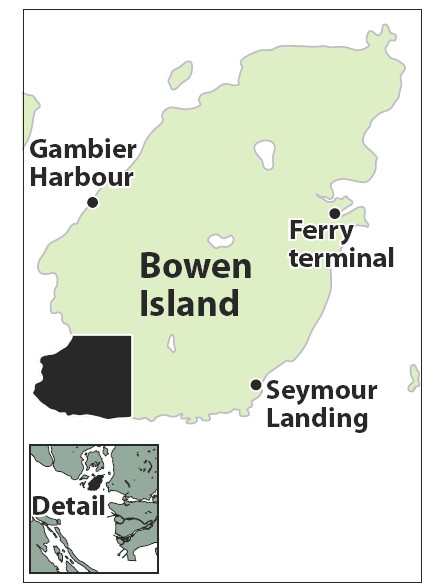Development group to turn southwestern tip of island into expensive subdivision
Derrick Penner
Sun

Bowen Island will soon have its own multi-million-dollar subdivision on this parcel of land.

A Vancouver-based development group is proceeding with plans to turn the southwestern tip of Bowen Island into a multi-million-dollar subdivision after an alternative proposal for a comprehensive community, including a park, collapsed last year.
The Cape on Bowen, a joint venture between Edwin Lee’s Leeda Development Group and Don Ho’s Trans City Group, launched sales last week for the first 14 premium 10-acre sites in what will be a 59-lot, $118-million development.
“It’s 35 minutes from downtown Vancouver, and a rare opportunity to own this kind of south-facing oceanfront estate-home site,” Lee said, promising the community will retain the area’s pristine natural state as much as possible.
“Our intent originally was to subdivide it,” Lee said in an interview about his and Ho’s purchase of the 248 hectares, known as Cape Roger Curtis, in 2004 for $16 million. (In 2010, BC Assessment valued the property at $27.7 million.) “So this is pretty much what we wanted to do.”
That proposal, however, wasn’t popular with the community when the developers first proposed it in 2004.
In an interview with BowenTV, which has a channel on YouTube, Lee said “there was a lot of opposition” to the subdivision application when it was first submitted.
In the same BowenTV video, Ho said the group was encouraged to consider a more comprehensive community with more housing types than single-family lots for millionaires, as well as a substantial park in an undeveloped area that has become coveted by the public.
Ho said the developers put considerable effort into establishing the community’s wants for a park and amenities and developed a comprehensive community plan that satisfied his company’s development needs with density, which it submitted for rezoning consideration in September 2008.
The proposal, however, proved to be “too large for the community,” Bowen Island Mayor Bob Turner said in an interview.
The developers were looking for significant density in exchange for reserving a large portion of the property as a park. It called for more than 600 housing units, Turner said, which was in excess of Bowen Island’s official community plan for the Cape Roger Curtis property.
“[The plan] had its supporters and opponents,” Turner said, but by the time Bowen’s municipal government considered it in May 2009, “by every way council could measure community support, indicators were that there was dominant opposition.”
Lee’s group withdrew the rezoning application and proceeded with its subdivision.
“Ultimately, the community preferred the low-density subdivision option that zoning allowed,” he added. “So we are quite comfortable that this provided the best option for the land.”
Though there will be no park, Lee said the subdivision will include a public one-kilometre shoreline trail and public access trails to some of the most popular public spots — the Cape Roger Curtis light, Cape Roger Curtis Beach and Collingwood Point.
Lee added that there will be other internal trails within other phases of the development that connect with the island’s trail systems.
“So actually, there is plenty of opportunity for residents to enjoy the property,” he said.
However, there is a sentiment that islanders missed an opportunity to get more out of the development to help build a more comprehensive community.
Neil Boyd, prominent Simon Fraser University criminologist and longtime Bowen resident, said there are probably people who like the subdivision because its low-density character helps restrict access to the island.
“I don’t think you build a community that way,” Boyd, a former Bowen Island councillor, said in an interview.
He also doubts that over time the Cape Roger Curtis project will remain a 59-lot development, because buyers will have rights to subdivide their lots.
Boyd said he understands the position that the proposed increase in density was perhaps too much for residents to accept, but he thought the trade-off of parkland, amenities and housing that would be more affordable to more people was worth it.
“To me the tragedy is just that there was not a compromise [between the community plan and 59-lot subdivision],” Boyd said.
© Copyright (c) The Vancouver Sun

